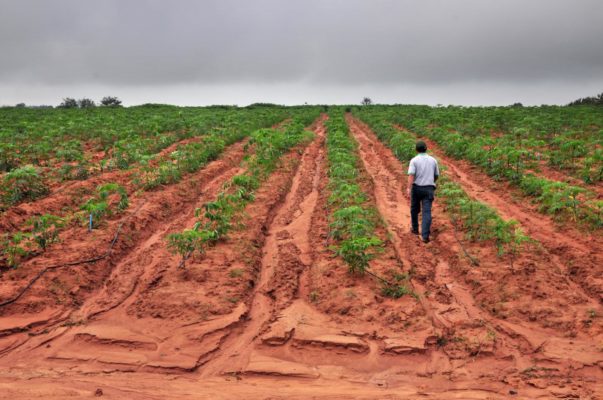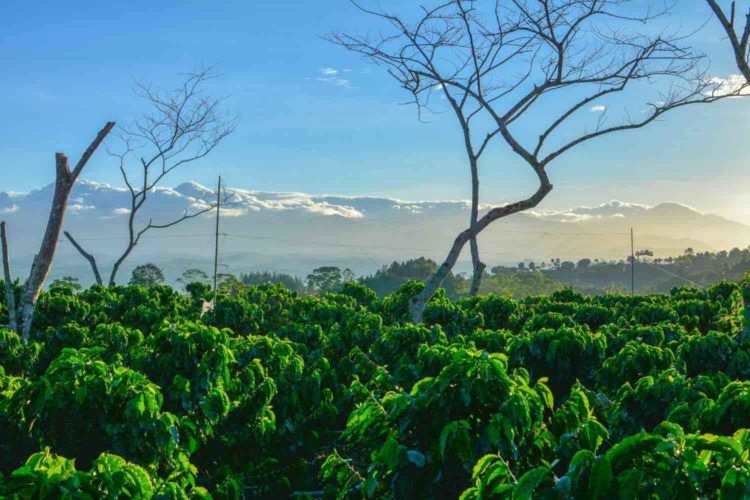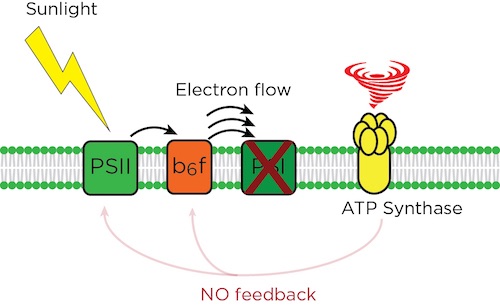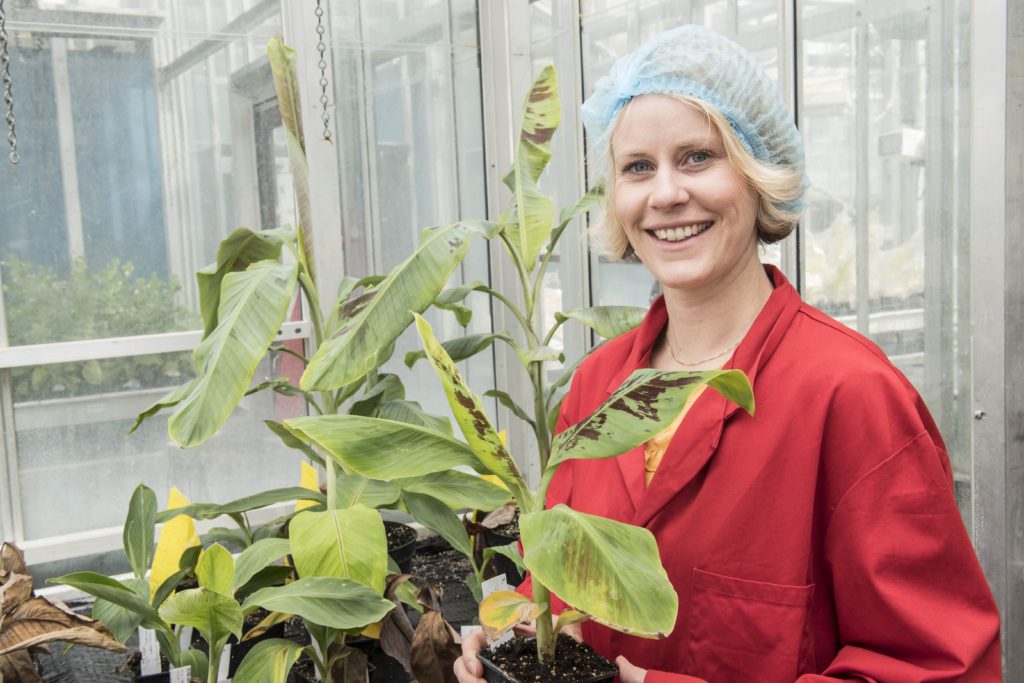
Valued at dining room tables and factory floors alike, cassava is worth about $10 billion in Asia. The continued growth of the commodity faces challenges from climate change, land degradation and limited investment in crop improvement and disease.

Valued at dining room tables and factory floors alike, cassava is worth about $10 billion in Asia. The continued growth of the commodity faces challenges from climate change, land degradation and limited investment in crop improvement and disease.

The researchers found that farms with diverse crops planted together provide more secure, stable habitats for wildlife and are more resilient to climate change than the single-crop standard that dominates today’s agriculture industry.

A team of researchers has successfully tested a new strategy for identifying genetic resources critical to the ongoing battle against plant pathogens such as bacteria, fungi and viruses that infect and destroy food crops worldwide.
By Atsuko Kanazawa, Igor Houwat, Cynthia Donovan
This article is reposted with permission from the Michigan State University team. You can find the original post here: MSU-DOE Plant Research Laboratory
Atsuko Kanazawa is a plant scientist in the lab of David Kramer. Her main focus is on understanding the basics of photosynthesis, the process by which plants capture solar energy to generate our planet’s food supply.
This type of research has implications beyond academia, however, and the Kramer lab is using their knowledge, in addition to new technologies developed in their labs, to help farmers improve land management practices.
One component of the lab’s outreach efforts is its participation in the Legume Innovation Lab (LIL) at Michigan State University, a program which contributes to food security and economic growth in developing countries in Sub-Saharan Africa and Latin America.
Atsuko recently joined a contingent that attended a LIL conference in Burkina Faso to discuss legume management with scientists from West Africa, Central America, Haiti, and the US. The experience was an eye opener, to say the least.
To understand some of the challenges faced by farmers in Africa, take a look at this picture, Atsuko says.
“When we look at corn fields in the Midwest, the corn stalks grow uniformly and are usually about the same height,” Atsuko says. “As you can see in this photo from Burkina Faso, their growth is not even.”
“Soil scientists tell us that much farmland in Africa suffers from poor nutrient content. In fact, farmers sometimes rely on finding a spot of good growth where animals have happened to fertilize the soil.”
Even if local farmers understand their problems, they often find that the appropriate solutions are beyond their reach. For example, items like fertilizer and pesticides are very expensive to buy.
That is where USAID’s Feed the Future and LIL step in, bringing economists, educators, nutritionists, and scientists to work with local universities, institutions, and private organizations towards designing best practices that improve farming and nutrition.
Atsuko says, “LIL works with local populations to select the most suitable crops for local conditions, improve soil quality, and manage pests and diseases in financially and environmentally sustainable ways.”
At the Burkina Faso conference, the Kramer lab reported how a team of US and Zambian researchers are mapping bean genes and identifying varieties that can sustainably grow in hot and drought conditions.
The team is relying on a new technology platform, called PhotosynQ, which has been designed and developed in the Kramer labs in Michigan.
PhotosynQ includes a hand-held instrument that can measure plant, soil, water, and environmental parameters. The device is relatively inexpensive and easy to use, which solves accessibility issues for communities with weak purchasing power.
The heart of PhotosynQ, however, is its open-source online platform, where users upload collected data so that it can be collaboratively analyzed among a community of 2400+ researchers, educators, and farmers from over 18 countries. The idea is to solve local problems through global collaboration.
Atsuko notes that the Zambia project’s focus on beans is part of the larger context under which USAID and LIL are functioning.
“From what I was told by other scientists, protein availability in diets tends to be a problem in developing countries, and that particularly affects children’s development,” Atsuko says. “Beans are cheaper than meat, and they are a good source of protein. Introducing high quality beans aims to improve nutrition quality.”
But, as LIL has found, good science and relationships don’t necessarily translate into new crops being embraced by local communities.
Farmers might be reluctant to try a new variety, because they don’t know how well it will perform or if it will cook well or taste good. They also worry that if a new crop is popular, they won’t have ready access to seed quantities that meet demand.
Sometimes, as Atsuko learned at the conference, the issue goes beyond farming or nutrition considerations. In one instance, local West African communities were reluctant to try out a bean variety suggested by LIL and its partners.
The issue was its color.
“One scientist reported that during a recent famine, West African countries imported cowpeas from their neighbors, and those beans had a similar color to the variety LIL was suggesting. So the reluctance was related to a memory from a bad time.”
This particular story does have a happy ending. LIL and the Burkina Faso governmental research agency, INERA, eventually suggested two varieties of cowpeas that were embraced by farmers. Their given names best translate as, “Hope,” and “Money,” perhaps as anticipation of the good life to come.
Another fruitful, perhaps more direct, approach of working with local communities has been supporting women-run cowpea seed and grain farms. These ventures are partnerships between LIL, the national research institute, private institutions, and Burkina Faso’s state and local governments.
Atsuko and other conference attendees visited two of these farms in person. The Women’s Association Yiye in Lago is a particularly impressive success story. Operating since 2009, it now includes 360 associated producing and processing groups, involving 5642 women and 40 men.
“They have been very active,” Atsuko remarks. “You name it: soil management, bean quality management, pest and disease control, and overall economic management, all these have been implemented by this consortium in a methodical fashion.”
“One of the local farm managers told our visiting group that their crop is wonderful, with high yield and good nutrition quality. Children are growing well, and their families can send them to good schools.”
As the numbers indicate, women are the main force behind the success. The reason is that, usually, men don’t do the fieldwork on cowpeas. “But that local farm manager said that now the farm is very successful, men were going to have to work harder and pitch in!”
Back in Michigan, Atsuko is back to the lab bench to continue her photosynthesis research. She still thinks about her Burkina Faso trip, especially how her participation in LIL’s collaborative framework facilitates the work she and her colleagues pursue in West Africa and other parts of the continent.
“We are very lucky to have technologies and knowledge that can be adapted by working with local populations. We ask them to tell us what they need, because they know what the real problems are, and then we jointly try to come up with tailored solutions.”
“It is a successful model, and I feel we are very privileged to be a part of our collaborators’ lives.”
This article is reposted with permission from the Michigan State University team. You can find the original post here: MSU-DOE Plant Research Laboratory
 This week we spoke to Dr. Joe Cornelius, the Program Director at the Advanced Research Projects Agency – Energy (ARPA-E). His work focusses on bioenergy production and conversion as a renewable and sustainable energy source, transportation fuel, and chemical feedstock, applying innovations in biotechnology, genomics, metabolic engineering, molecular breeding, computational analytics, remote sensing, and precision robotics to improve biomass energy density, production intensity, and environmental impacts.
This week we spoke to Dr. Joe Cornelius, the Program Director at the Advanced Research Projects Agency – Energy (ARPA-E). His work focusses on bioenergy production and conversion as a renewable and sustainable energy source, transportation fuel, and chemical feedstock, applying innovations in biotechnology, genomics, metabolic engineering, molecular breeding, computational analytics, remote sensing, and precision robotics to improve biomass energy density, production intensity, and environmental impacts.
What is ARPA-E? How are programs created?
The Advanced Research Projects Agency-Energy (ARPA-E) is a young government agency in the U.S. Department of Energy. The agency is modeled on a successful Defense Department program, the Defense Advanced Research Projects Agency (DARPA). Both agencies target high-risk, high-reward research in early-stage technologies that are not yet ready for private-sector investment.
Program development is one of the unique characteristics of the agency. ARPA-E projects are in the hands of term-limited program directors, who develop a broad portfolio of concepts that could make a large impact in the agency’s three primary mission areas: energy security, energy efficiency, and emissions reductions. The agency motto is “Changing what’s possible”, and we are always asking ourselves, “if it works, will it matter?”. Getting a program approved is a lot like a doing a PhD; you survey the field, host a workshop, determine key points to research, define aggressive performance metrics, and finally defend the idea to the faculty. If the idea passes muster, the agency makes a targeted investment. This flexibility was recently noticed as one of the great aspects of ARPA-E culture and is an exciting part of the job.
What is TERRA and how is it new for agriculture?
TERRA stands for Transportation Energy Resources from Renewable Agriculture, and its impact mission is to accelerate genetic gains in plant breeding. This is an advanced analytics platform for plant breeding. Today, significant scientific progress is possible through the convergence of diverse technologies, and TERRA’s innovation for breeders comes through the integration of remote sensing, computer vision, analytics, and genetics. The teams are using robots to carry cameras to the field and then extracting phenotypes and performing gene linkages. It’s really awesome to see.
This is run by the U.S. Department of Energy. How does TERRA tie into energy?
The United States has a great potential to generate biomass for conversion to cellulosic ethanol, but the crops useful for producing this biomass have not seen the improvement that others, such as soybeans or maize, have had. TERRA is focused on sorghum, which is a productive and resilient crop with existing commercial infrastructure that can yield advanced biomass on marginal lands. In addition, sorghum is a key food and feed crop, and the rest of the world will benefit from these advancements.
How does TERRA address the challenge of phenotyping in the field?
The real challenges that remain are in calibrating the sensor output and generating biological insight. A colleague from the United Kingdom, Tony Pridmore, captured the thought well, saying “Photography is not phenotying.” It’s generally easy to take the pictures — unless it’s very windy, the aerial platforms can pass over any crop, and the ground platforms are based on proven agricultural equipment. To get biological insights however, each team requires an analytics component, and a team from IBM is contributing their analytics expertise in collaboration with Purdue University.
What is most exciting about the TERRA program?
We commissioned the world’s biggest agricultural field robot, which phenotypes year-round. The six teams have successfully built other lightweight platforms involving tractors, rovers, mini-bots, and fixed and rotary wing unmanned aerial vehicles. It’s exciting to see some of the most advanced technologies move so quickly into the hands of great geneticists. The amazing thing is how quickly the teams have started generating phenotyping data. I expected it to take years before we got to this point, but the teams are knocking it out of the park, and we are entering into full-blown breeding systems deployment.
Who’s on the TERRA teams? How did you build the program?
ARPA-E system teams include large businesses, startups, and university groups. The program was built to have a full portfolio of diverse sensor suites, robotic platform types (ground and aerial), analytics approaches, and geographic breadth. Because breeders are working for a particular target population of environments, different phenotypes are valued differently across the various geographies. For that reason, each group is collecting its own set of phenotypes. Beyond that, we’ve worked very hard to encourage collaboration across the teams and have an exciting GxE (genotype x environment) experiment running, where several teams plant the same germplasm across multiple geographies. By combining this with high-throughput phenotyping, the teams are in a good position to determine key environmental inputs to various traits.
Once we achieve rapid-fire field phenotyping, what’s next?
We’re going underground! ARPA-E has made another targeted investment, this time in root phenotyping. We’re really excited about this one. It’s a very similar concept, but the sensing is so much harder. The teams have collaborated with medical, mining, aerospace, and defense communities for technologies that can allow us to observe root and soil systems in the field to allow breeders to improve crops. Ask us again next year—we will have some cool updates to both programs!
Reposted with kind permission from the MSU-DOE Plant Research Laboratory. Original article.

The need for speed: increasing plant yield is one way to increase food and fuel resources. But asking plants to simply do more of the usual is a strategy that can backfire. Photo by Romain Peli on Unsplash
When engineers want to speed something up, they look for the “pinch points”, the slowest steps in a system, and make them faster.
Say, you want more water to flow through your plumbing. You’d find the narrowest pipe and replace it with a bigger one.
Many labs are attempting this method with photosynthesis, the process that plants and algae use to capture solar energy.
All of our food and most of our fuels have come from photosynthesis. As our population increases, we need more food and fuel, requiring that we improve the efficiency of photosynthesis.
But, Dr. Atsuko Kanazawa and the Kramer Lab are finding that, for biological systems, the “pinch point” method can potentially do more harm than good, because the pinch points are there for a reason! So, how can this be done?
Atsuko and her colleagues at the MSU-DOE Plant Research Laboratory (PRL) have been working on this problem for over 15 years. They have focused on a tiny machine in the chloroplast called the ATP synthase, a complex of proteins essential to storing solar energy in “high energy molecules” that power life on Earth.
That same ATP molecule and a very similar ATP synthase are both used by animals, including humans, to grow, maintain health, and move.
In plants, the ATP synthase happens to be one of the slowest process in photosynthesis, often limiting the amount of energy plants can store.

Photosynthetic systems trap sunlight energy that starts the reaction to move electrons forward in an assembly-line fashion to make useful energy compounds. The ATP synthase is one of the “pinch points” that slows the flow as needed, so plants stay healthy. In cfq, the absence of feedback leads to an electron pile up at PSI, and a crashed system. By MSU-DOE Plant Research Laboratory, except tornado graphic/CC0 Creative Commons
Atsuko thought, if the ATP synthase is such an important pinch point, what happens if it were faster? Would it be better at photosynthesis and give us faster growing plants?
Years ago, she got her hands on a mutant plant, called cfq, from a colleague. “It had an ATP synthase that worked non-stop, without slowing down, which was a curious example to investigate. In fact, under controlled laboratory conditions – very mild and steady light, temperature, and water conditions – this mutant plant grew bigger than its wild cousin.”
But when the researchers grew the plant under the more varied conditions it experiences in real life, it suffered serious damage, nearly dying.
“In nature, light and temperature quality change all the time, whether through the passing hours, or the presence of cloud cover or winds that blow through the leaves,” she says.
Atsuko’s research now shows that the slowness of the ATP synthase is not an accident; it’s an important braking mechanism that prevents photosynthesis from producing harmful chemicals, called reactive oxygen species, which can damage or kill the plant.
“It turns out that sunlight can be damaging to plants,” says Dave Kramer, Hannah Distinguished Professor and lead investigator in the Kramer lab.
“When plants cannot use the light energy they are capturing, photosynthesis backs up and toxic chemicals accumulate, potentially destroying parts of the photosynthetic system. It is especially dangerous when light and other conditions, like temperature, change rapidly.”
“We need to figure out how the plant presses on the brakes and tune it so that it responds faster…”
The ATP synthase senses these changes and slows down light capture to prevent damage. In that light, the cfqmutant’s fast ATP is a bad idea for the plant’s well-being.
“It’s as if I promised to make your car run faster by removing the brakes. In fact, it would work, but only for a short while. Then things go very wrong!” Dave says.
“In order to improve photosynthesis, what we need is not to remove the brakes completely, like in cfq, but to control them better,” Dave says. “Specifically, we need to figure out how the plant presses on the brakes and tune it so that it responds faster and more efficiently,” David says.
Atsuko adds: “Scientists are trying different methods to improve photosynthesis. Ultimately, we all want to tackle some long-term problems. Crucially, we need to continue feeding the Earth’s population, which is exploding in size.”
The study is published in the journal, Frontiers in Plant Science.
A scenario starring the root crop was portrayed in the movie “The Martian” (2015), in which a lost astronaut, played by Matt Damon, survives on potatoes he cultivates on the red planet while awaiting rescue.
But in addition to this interplanetary possibility, scientists also observed the crop is genetically suited to adapting to the changes creating more adverse environmental conditions on Earth.
So before turning fiction into reality, the tuber has a mission on Earth.
The study has identified four types of potatoes, out of 65 examined, which have shown resistance to high salinity conditions and were able to form tubers in a type of soil similar to that on Mars.
One of these is the Tacna variety, developed in Peru in 1993. It was introduced to China shortly afterwards, where it showed high tolerance to droughts and saline soils with hardly any need for irrigation.
This variety became so popular in China that it was ‘adopted’ in 2006 under the name of Jizhangshu 8. The same high tolerance was seen on the saline and arid soils of Uzbekistan, a country with high temperatures and water shortages, where the variety was also introduced and renamed as Pskom.
The second variety that passed the salinity test is being cultivated in coastal areas of Bangladesh that have high salinity soils and high temperatures. The other two types are promising clones — potatoes that are being tested for attributes that would make them candidates for becoming new varieties.
These four potato types were created as a result of the CIP’s breeding programme to encourage adaptation to conditions in subtropical lowlands, such as extreme temperatures, which are expected to be strongly affected by climate change.
Down to Earth
In addition to these four potato ‘finalists’, other clones and varieties have shown promising results when tested in severe environmental conditions. The findings offer researchers new clues about the genetic traits that can help tubers cope with severe weather scenarios on Earth.
“It was a pleasant surprise to see that the potatoes that we have improved to tolerate adverse conditions were able to produce tubers on this soil [soil similar to that on Mars],” says Walter Amorós, CIP potato breeder and one of the five researchers involved in the project, who has studied potatoes for more than 30 years.
According to Alberto García, adviser to the UN Food and Agriculture Organization in Peru who is in charge of food security programmes, this experiment “serves to verify that potato, a produce of great nutritional value, is a crop extremely adaptable to the worst conditions”, something that is very relevant for current climate scenarios.
García stresses that global temperatures are now rising at a rate higher than expected, affecting not only potatoes but also other crops. Many now need to be cultivated at higher altitudes — which, he says, is not always a disadvantage and may even be beneficial for crops that were previously cultivated in valleys.
“But it can also have negative consequences that we have to anticipate,” adds García. Therefore, he says this experiment can inspire others to think about future scenarios and look for other crops than can adapt to extreme conditions that will have an impact on agriculture.
The project began with a search for soils similar to that found on Mars. Julio Valdivia-Silva, a Peruvian researcher who worked at NASA’s Ames Research Center, eventually concluded that the soil samples collected in the Pampas de la Joya region of southern Peru were the most similar to Martian soil.
Arid, sterile and formed by volcanic rocks, these soil samples were extremely saline.
Helped by engineers from the University of Engineering and Technology (UTEC) in Lima and based on designs by NASA’s Ames Research Center, the CIP built CubeSat — a miniature satellite that recreates, in a confined environment, a Martian-like atmosphere. This is where the potatoes were cultivated.
“If potatoes could tolerate the extreme conditions to which we exposed them in our CubeSat, they have a good opportunity to develop on Mars,” says Valdivia-Silva.
They then conducted several rounds of experiments to find out which varieties could better withstand the extreme conditions, and what minimum conditions each crop needed to survive.
CubeSat, hermetically sealed, housed a container with La Joya soil, where each one of the tubers was cultivated. CubeSat itself supplied water and nutrients, controlled the temperature according to that expected at different times on Mars, and also regulated the planet’s pressure, oxygen and carbon dioxide levels.
Cameras were installed to record the process, broadcasting developments on the soil and making it possible to see the precise moment in which potatoes sprouted.
Based on the results, CIP scientists say that in order to grow potatoes on Mars, space missions will have to prepare the soil so it has a loose structure and contains nutrients that allow the tubers to obtain enough oxygen and water.
In a next phase of the project, the scientists hope to expose successful varieties to more extreme environmental conditions. This requires, among other things, developing a prototype satellite similar to CubeSat that can replicate more extreme conditions with greater precision, at a price tag of US$ 100,000.
This piece was produced by SciDev.Net’s Latin America and Caribbean desk.
This article was originally published on SciDev.Net. Read the original article.
This article was republished from SciDev.Net.
Relocating coffee areas, along with forestation and forest conservation, to higher altitudes to cope with climate change could increase Ethiopia‘s coffee farming area fourfold, a study predicts.
The study, published in Nature last month (19 June), suggests that moving Ethiopian coffee fields to higher ground because of climate change could increase resilience by substantially increasing the country’s suitable production area.
Justin Moat, spatial analyst at the UK’s Royal Botanic Gardens Kew, and lead author of the study, says that currently coffee farming is mainly confined to altitudes between 1200 and 2200 metres.
“A critical factor in the suitability of coffee farming is the interaction between rainfall and temperature.”
Justin Moat
“In general, coffee’s niche will move uphill to keep to optimal temperature,“ he tells SciDev.Net. “Much work would be needed to achieve this if planning starts now.”
According to Moat, up to 60 per cent of the country‘s current production area could become unsuitable before the end of the century.
Ethiopia, he says, is the world’s 5th largest coffee producer. The crop provides a quarter of export earnings, and approximately 15 million Ethiopians engage in coffee farming and production.
The study‘s results were based on computer modelling and simulations. “We determined coffee-preferred climate (niche) using a huge amount of data collected on the ground, including historic observations, overlaid on climate maps,” explains Moat.
They projected this niche into the future using climate models and scenarios, which revealed that all the models were in general agreement. They then combined this with satellite imagery to come up with the present-day forest coffee area, and the area projected in the future.
Higher altitudes are forecast to become more suitable for coffee while lower altitudes are projected to become less suitable, according to the study.
“A critical factor in the suitability of coffee farming is the interaction between rainfall and temperature; higher temperatures could be tolerated if there was an increase in rainfall,” Moat notes.
He adds that regardless of interventions, one of the country‘s best known coffee-growing regions — Harar, in eastern Ethiopia — is likely to disappear before the end of the century.
Shem Wandiga, a professor of chemistry at the University of Nairobi’s Institute for Climate Change Adaptation, Kenya, says that although the study cannot predict with full certainty, it holds important messages for policymakers.
“Start planning to expand coffee growing areas to higher elevation, he suggests. “The expansion should be coupled with forestation of the areas.“
Researchers and policymakers should also map out the human, social and ecological conditions that may allow such expansion, according to Wandiga. Also, farmers should slowly substitute coffee with other plants that may bring income.
William Ndegwa, Kitui County director at the Kenya Meteorological Department, says the model used in the research is a powerful tool for linking climate variables with biological parameters.
“This is a very interesting [study] with deep insights into the characteristics of the impacts of climate change on crop production,” he notes.
This piece was produced by SciDev.Net’s Sub-Saharan Africa-English desk.
This article was originally published on SciDev.Net. Read the original article.
 Dr. Sarah Schmidt (@BananarootsBlog), Researcher and Science Communicator at The Sainsbury Laboratory Science. Sarah got hooked on both banana research and science writing when she joined a banana Fusarium wilt field trip in Indonesia as a Fusarium expert. She began blogging at https://bananaroots.wordpress.com and just filmed her first science video. She speaks at public events like the Pint of Science and Norwich Science Festival.
Dr. Sarah Schmidt (@BananarootsBlog), Researcher and Science Communicator at The Sainsbury Laboratory Science. Sarah got hooked on both banana research and science writing when she joined a banana Fusarium wilt field trip in Indonesia as a Fusarium expert. She began blogging at https://bananaroots.wordpress.com and just filmed her first science video. She speaks at public events like the Pint of Science and Norwich Science Festival.
Every morning I slice a banana onto my breakfast cereal.
And I am not alone.
Every person in the UK eats, on average, 100 bananas per year.
Bananas are rich in fiber, vitamins, and minerals like potassium and magnesium. Their high carbohydrate and potassium content makes them a favorite snack for professional sports players; the sugar provides energy and the potassium protects the players from muscle fatigue. Every year, around 5000 kg of bananas are consumed by tennis players at Wimbledon.
But bananas are not only delicious snacks and handy energy kicks. For around 100 million people in Sub-Saharan Africa, bananas are staple crops vital for food security. Staple crops are those foods that constitute the dominant portion of a standard diet and supply the major daily calorie intake. In the UK, the staple crop is wheat. We eat wheat-based products for breakfast (toast, cereals), lunch (sandwich), and dinner (pasta, pizza, beer).
In Uganda, bananas are staple crops. Every Ugandan eats 240 kg bananas per year. That is around 7–8 bananas per day. Ugandans do not only eat the sweet dessert banana that we know; in the East African countries such as Kenya, Burundi, Rwanda, and Uganda, the East African Highland banana, called Matooke, is the preferred banana for cooking. Highland bananas are large and starchy, and are harvested green. They can be cooked, fried, boiled, or even brewed into beer, so have very similar uses wheat in the UK.
In West Africa and many Middle and South American countries, another cooking banana, the plantain, is cooked and fried as a staple crop.
In terms of production, the sweet dessert banana we buy in supermarkets is still the most popular. This banana variety is called Cavendish and makes up 47% of the world’s banana production, followed by Highland bananas (24%) and plantains (17%). Last year, I visited Uganda and I managed to combine the top three banana cultivars in one dish: cooked and mashed Matooke, a fried plantain and a local sweet dessert banana!
Another important banana cultivar is the sweet dessert banana cultivar Gros Michel, which constitutes 12% of the global production. Gros Michel used to be the most popular banana cultivar worldwide until an epidemic of Fusarium wilt disease devastated the banana export plantations in the so-called “banana republics” in Middle America (Panama, Honduras, Guatemala, Costa Rica) in the 1950s.
Fusarium wilt disease is caused by the soil-borne fungus Fusarium oxysporum f. sp. cubense (FOC). The fungus infects the roots of the banana plants and grows up through the water-conducting, vascular system of the plant. Eventually, this blocks the water transport of the plant and the banana plants start wilting before they can set fruits.
The Fusarium wilt epidemic in Middle America marked the rise of the Cavendish, the only cultivar that could be grown on soils infested with FOC. The fact that they are also the highest yielding banana cultivar quickly made Cavendish the most popular banana variety, both for export and for local consumption.
Currently, Fusarium wilt is once again the biggest threat to worldwide banana production. In the 1990s, a new race of Fusarium wilt – called Tropical Race 4 (TR4) – occurred in Cavendish plantations in Indonesia and Malaysia. Since then, TR4 has spread to the neighboring countries (Taiwan, the Philippines, China, and Australia), but also to distant locations such as Pakistan, Oman, Jordan, and Mozambique.
In Mozambique, the losses incurred by TR4 amounted to USD 7.5 million within just two years. Other countries suffer even more; TR4 causes annual economic losses of around USD 14 million in Malaysia, USD 121 million in Indonesia, and in Taiwan the annual losses amount to a whopping USD 253 million.
TR4 is not only diminishing harvests. It also raises the price of production, because producers have to implement expensive preventative measures and treatments of affected plantations. These preventive measures and treatments are part of the discussion at The World Banana Forum (WBF). The WBF is a permanent platform for all stakeholders of the banana supply chain, and is housed by the United Nation’s Food and Agricultural Organization (FAO). In December 2013, the WBF created a special taskforce to deal with the threat posed by TR4.
Despite its massive impact on banana production, we know very little about the pathogen that is causing Fusarium wilt disease. We don’t know how it spreads, why the new TR4 is so aggressive, or how we can stop it.
Breeding bananas is incredibly tedious, because edible cultivars are sterile and do not produce seeds. I am therefore exploring other ways to engineer resistance in banana against Fusarium wilt. As a scientist in the 2Blades group at The Sainsbury Laboratory, I am investigating how we can transfer resistance genes from other crop species into banana and, more recently, I have been investigating bacteria that are able to inhibit the growth and sporulation of F. oxysporum. These biologicals would be a fast and cost-effective way of preventing or even curing Fusarium wilt disease.
Twitter: @BananarootsBlog
Email: mailto:sarah.schmidt@tsl.ac.uk
Website: https://bananaroots.wordpress.com
This article was originally published on SciDev.Net. Read the original article.
Brazil is the second country, after Indonesia, to approve the commercial cultivation of GM sugarcane. The approval was announced by the Brazilian National Biosafety Technical Commission (CTNBio) on June 8.
Sugarcane borer is one of the main pests of the sugarcane fields of South-Central Brazil, causing losses of approximately US$1.5 billion per year.
“Breeding programmes could not produce plants resistant to this pest, and the existing chemical controls are both not effective and severely damaging to the environment,” says Adriana Hemerly, a professor at the Federal University of Rio de Janeiro, in an interview with SciDev.Net.
“Studies conducted outside Brazil prove that protein from genetically modified organisms harms non-target insects, soil fauna and microorganisms.”
Rogério Magalhães
“Therefore, the [GM variety] is a biotechnological tool that helps solve a problem that other technologies could not, and its commercial application will certainly have a positive impact on the productivity of sugarcane in the country.”
Jesus Aparecido Ferro, a member of CTNBio and professor at the Paulista Júlio de Mesquita Filho State University, believes the move followed a thorough debate that began in December 2015 — that was when the Canavieira Technology Center (Sugarcane Research Center) asked for approval to commercially cultivate the GM sugarcane variety.
“The data does not provide evidence that the cane variety has a potential to harm the environment or human or animal health,” Ferro told SciDev.Net.
To develop the variety, scientists inserted the gene for a toxin [Cry] from the bacterium Bacillus thuringiensis (Bt) into the sugarcane genome, so it could produce its own insecticide against some insects’ larvae.
This is a technology that “has been in use for 20 years and is very safe”, says Aníbal Eugênio Vercesi, another member of the CTNBio, and a professor at the State University of Campinas.
But Valério De Patta Pillar, also a member of the CTNBio and a professor at the Federal University of Rio Grande do Sul, points to deficiencies in environmental risk assessment studies for the GM variety — and the absence of assessments of how consuming it might affect humans and animals.
According to Pillar, there is a lack of data about the frequency with which it breeds with wild varieties. Data is also missing on issues such as the techniques used to create the GM variety and the effects of its widespread use.
Rogério Magalhães, an environmental analyst at Brazil’s Ministry of the Environment, also expressed concern about the approval of the commercial transgenic cane.
“I understand that studies related to the impacts that genetically modified sugarcane might have on Brazilian biodiversity were not done by the company that owns the technology,” said Magalhães in an interview with SciDev.Net. This is very important because Brazil’s climate, species, and soils differ from locations where studies might have taken place, he explained.
Among the risks that Magalhães identified is contamination of the GM variety’s wild relatives. “The wild relative, when contaminated with transgenic sugarcane, will have a competitive advantage over other uncontaminated individuals, as it will exhibit resistance to insect-plague that others will not have,” he explained.
Another risk that Magalhães warns about is damage to biodiversity. “Studies conducted outside Brazil prove that Cry protein from genetically modified organisms harms non-target insects, soil fauna and microorganisms.”
Magalhães added that some pests have already developed resistance to the Bt Cry protein, prompting farmers to apply agrochemicals that are harmful to the environment and human health.
This piece was originally published by SciDev.Net’s Latin America and Caribbean desk.
This article was originally published on SciDev.Net. Read the original article.